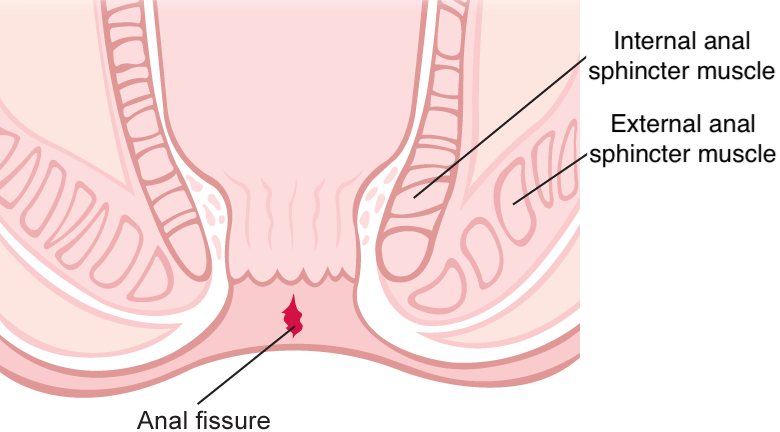About Anal Fissures
What is an Anal Fissure?

Why are anal fissures so painful?
An anal fissure is a common and painful condition appearing as a small tear near the external anal opening. Anal fissures can occur spontaneously or as a result of difficult bowel movements. While anal fissures are almost always benign, they are usually tender and painful, especially during bowel evacuation. About one million patients are diagnosed with fissures each year.
Keeping the anal sphincter muscle relaxed to prevent spasm is critical to reduce pain and break the anal fissure cycle.

Options for reducing pain and healing your fissure
1. Surgical Sphincterotomy - A surgical division of all or part of the spastic internal anal sphincter. This surgical procedure eliminates sphincter spasm and allows for healing of the fissure. General anesthesia is usually required. Some degree of postoperative incontinence for flatus or feces occurs in up to one-third of patients.
2. Chemical Sphincterotomy - In-home procedure in which patient uses a science-based pharmacological sphincter relaxant to relax the internal anal sphincter muscle. Examples include calcium channel blockers (Diltiazem, Nifedipine) or Nitroglycerine.
What is a "Chemical Sphincterotomy"?
Chemical sphincterotomy is a non-surgical process, which eliminates anal sphincter spasm using a pharmacological sphincter relaxant (Fissure Medication) delivered directly to the lining of the anus. Chemical sphincterotomy has become increasingly popular as a first therapeutic option in patients with fissures. Examples of sphincter relaxant medications include Diltiazem, Nifedpine and Nitroglycerine.
Will Chemical Sphincterotomy eliminate the pain caused by my anal fissure?
Spasm of the internal anal sphincter can be relieved by using Fissure Medications such as calcium channel blockers (Nifedipine, Diltiazem) and topical nitrates (Nitroglycerine) whose action on the internal anal sphincter will cause it to relax and thereby eliminate the pain.¹

How do I apply the Fissure Medication for Chemical Sphincterotomy?
Studies have shown that it is important to deliver Fissure Medications directly into the anal canal. DoseRite has developed a unique and proprietary delivery system that ensures the Fissure Medication is applied directly to the anal lining, exactly one measured dose at a time. Topical application within the anal canal 2 to 3 times per day is the most effective way to keep the sphincter muscle relaxed and eliminate spasm and severe pain. Depending on the severity of the muscle spasm it may take anywhere from a day to several weeks for the sphincter muscle to relax.
Common Misconceptions about Chemical Sphincterotomy
Rubbing a pea-size amount of medication on the outside of the anal opening is simply not enough medication to relax the sphincter muscle, especially when applied outside of the anal canal. The risk of headaches with larger doses is significantly reduced if the patient can apply the medication internally without contacting the keratized skin of the fingers or outer anus. Another misconception in anal fissure treatment is that medications should be applied directly to the fissure like an antibiotic ointment. Since most Fissure Medications are sphincter muscle relaxants, applying these medications directly to the fissure does little to heal the tear and may actually cause more discomfort and irritation.
DoseRite Simplifies Anal Application
DoseRite's patented anal applicator provides a painless and straightforward way to accurately apply Fissure Medication within the anal canal. The applicator's side slotted design ensures medication is applied directly to the anoderm for efficient absorption by the internal sphincter muscle. The applicator's safety flange ensure the tip is inserted to a safe depth and the closed-end design prevents unwanted delivery in the rectum. The length of the inserted portion is approximately 3.5 cm and is the diameter of a pencil.
DoseRite allows patients to transfer and apply a single dose of Fissure Medication from a tube or jar without direct contact with the medication. As a result, side effects such are headaches are greatly reduced even at larger doses (0.3cc-0.5cc).²

1. American Gastroenterological Association Recommendations for the Treatment of Anal Fissure (PDF).
2. Torrabadella L., Salgado G., Controlled Dose Delivery in Topical Treatment of Anal Fissure: Pilot Study of a New Paradigm. Dis Colon Rectum 2005; 49: 865–868. DOI: 10.1007/s10350-005-0270-y
3. American Society of Colon and Rectal Surgeons. Anal Fissure Expanded Information.
